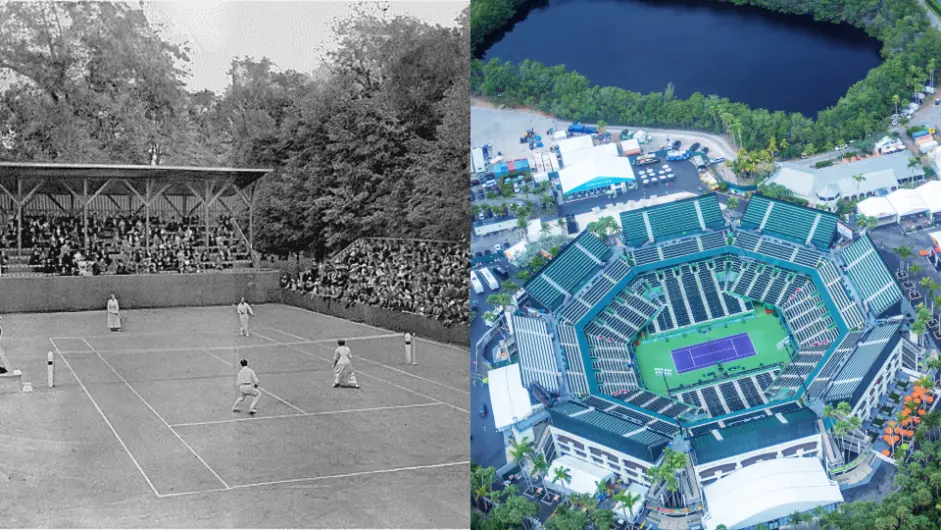How Tennis Became a Sport: From Medieval Jeu de Paume to Modern Grand Slams
Updated on
Published on

As a lifelong tennis fan, I often wonder how tennis became a sport enjoyed by millions worldwide. The history of tennis stretches from hand‑ball games in medieval monasteries to high‑tech showdowns on center court. This narrative tour covers the origin of tennis, the evolution of tennis rules and equipment, the rise of lawn tennis, and the tournaments and stars who shaped the modern game. By the end, you will know who invented tennis in its earliest form and how it grew into a global spectacle.
Origins in Medieval France
Early versions of tennis appeared in twelfth‑century France as jeu de paume, literally “game of the palm,” played by monks who struck a cloth or leather ball with bare hands. Gloves, paddles, and finally stringed rackets followed by the sixteenth century. European nobility embraced the indoor game, which later became known as “real tennis.” Kings such as Henry VIII built private courts, giving the pastime elite status. Although rules and scoring were complex, tennis planted cultural roots that would endure.
Birth of Lawn Tennis in Victorian England
The nineteenth century introduced a game‑changing material: vulcanized rubber. Bouncy balls could now be used on grass. In 1873, British Army major Walter Clopton Wingfield packaged a boxed set called Sphairistikè, complete with rackets, rubber balls, net, and rule book. Within two years, London’s Marylebone Cricket Club published standardized lawn‑tennis rules, and in 1877 the All England Club held the inaugural Wimbledon Championship. Lawn tennis, easily set up in gardens and parks, spread rapidly through Britain and the wider world, appealing to men and women alike.
Evolution of Rules and Equipment
- Rackets: Wooden frames ruled for centuries until steel and aluminum arrived in the 1960s. Graphite composites in the 1980s produced lighter, more powerful rackets that revolutionized play.
- Balls: Early balls were cloth‑stuffed or solid wood. Rubber cores covered with flannel created a consistent bounce on grass, clay, and eventually hard courts. Television visibility later prompted the switch from white to optic yellow.
- Courts and Scoring: The familiar 78‑by‑27‑foot rectangle, three‑foot‑high net, and quirky 15‑30‑40 scoring were codified in 1875. The tiebreak was introduced in 1970, ending marathon sets.
- Technology: Hawk‑Eye line‑calling and serve clocks keep today’s matches accurate and fast‑paced, blending tradition with innovation.
Rise of Competitive Tennis and the Grand Slams
Organized championships emerged quickly:
- 1877 – Wimbledon became the first major grass‑court event.
- 1881 – U.S. National Championship (now the US Open) launched on the American East Coast.
- 1891 – French Championship established clay‑court prestige.
- 1905 – Australasian Championship evolved into the Australian Open.
Together these four tournaments form the Grand Slams, tennis’s highest honors. Team events like the Davis Cup in 1900 and Fed Cup (now Billie Jean King Cup) in 1963 added national pride to the mix.
- What Is Wimbledon? Understanding The Sacred Sanctuary of Tennis
- Who Has Won Wimbledon the Most? Record-Breaking Champions
- The 10 Richest Tennis Players in the World
The Open Era and Professional Boom
For decades, amateurs played the majors while professionals barnstormed for pay. In 1968, tennis authorities unified the sport by allowing pros and amateurs to compete together, ushering in the Open Era. Prize money soared, television audiences exploded, and stars such as Rod Laver, Billie Jean King, Chris Evert, Björn Borg, and later Roger Federer, Serena Williams, Rafael Nadal, and Novak Djokovic became household names. Tennis returned to the Olympics in 1988, further cementing its global reach.
Cultural and Social Impact
Tennis has long bridged social divides. Victorian lawn parties showcased mixed‑gender play, while Billie Jean King’s 1973 “Battle of the Sexes” victory advanced gender equality. Arthur Ashe’s Grand Slam wins broke racial barriers, and global tours brought the sport to every continent. From the lacoste polo shirt to strawberries and cream at Wimbledon, tennis influences fashion and tradition alike.
Timeline Highlights
- 1100s: Jeu de paume played by French monks
- 1500s: Stringed rackets introduced
- 1873: Wingfield markets lawn‑tennis kit
- 1877: First Wimbledon Championship
- 1900: Davis Cup inaugurated
- 1968: Open Era begins
- 1988: Tennis reinstated as full Olympic sport
FAQ: History of Tennis
What is the origin of tennis?
Tennis originated in medieval France as jeu de paume, a hand‑ball game later played with rackets.
Who invented tennis?
Modern lawn tennis evolved gradually, but Major Walter Clopton Wingfield popularized it in 1873 by packaging rules and equipment for easy adoption.
Why is tennis scoring 15‑30‑40?
The system likely stems from medieval clock‑face increments or French betting terms, preserved as part of the sport’s heritage.
What are the four Grand Slam tournaments?
Wimbledon, US Open, French Open, and Australian Open are the sport’s premier events.
How did tennis become a professional sport?
The 1968 Open Era allowed professionals into major tournaments, unlocking prize money, global TV coverage, and modern tour structures.









